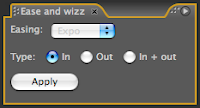 It would be great if this was posted on Vimeo or PVC, like AENY's recent meeting...SFMOGRAPH
It would be great if this was posted on Vimeo or PVC, like AENY's recent meeting...SFMOGRAPH is having a meeting on February 26th at Adobe on Townsend Street in SF. You must pre-register for this event. Here's an almost verbatim description of the agenda:
'The February SFMOGRAPH meeting will revolve around
Red Camera workflow in After Effects. Mark Christiansen [author of
After Effects CS4 Visual Effects and Compositing Studio Techniques] will be kicking off the meeting with an in-depth look. Mark has worked extensively with .R3D files along with a long history working with film, so he has an in-depth knowledge of the "old" process compared to Red. Hopefully, Matt Silverman will chime in too.
Plug-in of the month is going to be comprised of numerous plug-ins that go hand in hand with the Red workflow. We'll take a look at the standard built-in color correction tools in AE, and explain where 3rd party color correctors like Color Finesse, Colorista, Frishcluft Curves, and Magic Bullet Looks fit into the picture.
Lastly we're hoping to see Red work done by anyone in the audience who can bring in clips to share. Please make sure these clips are in Quicktime format.'
Note: Mark's findings should help iron out any wrinkles of this ".01" update; for a prefiguring, see the post by
Michael Coleman, After Effects product manager,
Tips for Editing and Finishing RED Raw Files with Adobe CS4 Workflows on Studio Daily. To use the updates (from both Adobe and RED), you'd need to meet the hefty system requirements -- and don't forget to change AE’s “interpretation rules.txt” file. It seems that the only color space supported RED's CS4 importer software is Rec709.
There's more on
Red Camera workflow from various other sources in previous posts; here's a video (loud to start) on using RED Camera RAW and CS4 by Dave Helmley, which can be viewed
fullscreen at Adobe TV:
Update:
Final Cut Pro-L has a nice thread on RED workflow. Also interesting is "
The Truth About 2K, 4K and The Future of Pixels" by John Galt at Creative Cow, and the
Red User Discussion in response. Jim Tierney at Digital Anarchy has
additional thoughts and links to an article that explains the difference between sensors.
 DNM has collected its own old & new After Effects tutorials, mostly by Ko Maruyama, in 300+ Free After Effects Tutorials.
DNM has collected its own old & new After Effects tutorials, mostly by Ko Maruyama, in 300+ Free After Effects Tutorials.



































